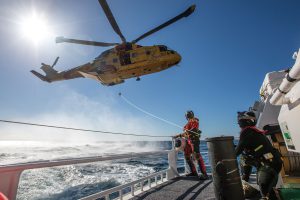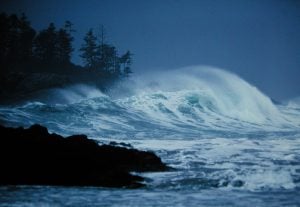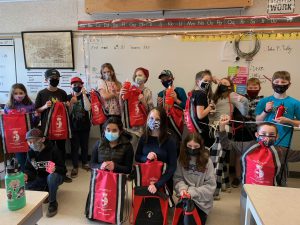
People & Culture
Safety first, service always: The Canadian Coast Guard turns 60
A celebration of the Canadian Coast Guard’s renowned search-and-rescue capabilities — and more — as the special operating agency turns 60
- 4392 words
- 18 minutes
Travel
Offering something for everyone, this 584-kilometre wind-swept shoreline is packed with historical sites, isolated beaches, quiet seaside towns and more

Storm watching has always felt like one-part thrill and two-part clever low-season tourism marketing. Safely experiencing a powerful weather event can deliver an undeniable spectacle, but if the timing is off, you may be frustratingly boxed in with bad weather. Monitoring the weather report in late December 2023, it felt right to pack the kids into the car, drive south from Vancouver, and see what we might discover. Our destination is one of the most dramatic coastlines in North America at its wet, stormy and rugged best.

A Washington State trooper inexplicably follows my car for an hour, all the way to the longest truss bridge in North America. Perhaps he’s not used to seeing B.C. plates when the traffic is sparse, and vacancy signs are lit at this time of year. We turn onto the engineering marvel that is the 6.5-kilometre-long Astoria-Megler Bridge, cross state lines into Oregon, and become another trooper’s problem. The bullet-straight bridge rises dramatically, allowing ships to safely enter the port of Astoria (Oregon’s oldest town) and the first permanent American settlement west of the Rockies. This is Lewis and Clark country; the famed American explorers reached the region in 1805. They packed up and headed east after months of horrendous rain, fog and wind. It should be noted that storm-watching wasn’t a thing in those days.
By the end of the 19th century, Astoria grew prosperous with its fishing, logging and port industries, attracting many immigrants from Sweden, Finland, China and India. Stately wooden manors from that era are everywhere, and the town boasts hundreds of houses of historic significance. It all looks vaguely familiar, explained when we pop into the old county jailhouse, now home to the Oregon Film Museum. 1980s Hollywood loved Astoria, which welcomed Short Circuit, Free Willy, Kindergarten Cop and most famously, The Goonies (enjoying a revival thanks to child actor Ke Huy Quan winning an unlikely Oscar in 2023). The tiny museum is packed with Goonies memorabilia and some neat interactive exhibits. History followed us downtown to the 100-year-old Hotel Elliott, with its fabulous rooftop view and a short walk to the Columbia River Maritime Museum. It was time to learn more about the havoc the storms have wreaked.
Among seafarers, the coastline from Oregon to Vancouver Island is known as the Graveyard of the Pacific. Thousands of ships and their passengers have been lost due to wild weather, sharp reefs, and unpredictable conditions. Approaching Astoria, the Columbia River meets the Pacific, resulting in the notorious Columbia Bar: a five-km-wide and 10km-long stretch of shifting sand and shoals in a region smothered with fog, wind and heavy rain. The Columbia River Maritime Museum charts 238 known shipwrecks along the bar, immersing visitors into the past and present with interactive displays, a 3D theatre, naval equipment, a docked lightship and other fascinating artifacts. I jam the kids into a Hurricane Simulator so they can feel the power of 100 km/hr wind. On my weather app, a Storm Warning is now in effect, with winds on the coast expected from 80km/hr to 115 km/hr.

“If you live around here, you’ll know that’s not really impressive,” says the receptionist at the Elizabeth Oceanfront Suites in Newport. I had shown him the storm warning when we checked in, hoping for a more inspired reaction. We’d driven three hours down the coast, pulling over at empty viewpoints to watch massive waves crash into rocks, bays and beaches. In summer, crowds pack into towns like Cannon Beach and Seaside, but at this time of year, it felt like we had the region – and coveted viewpoint parking spots – to ourselves. At low tide, we visited Fort Stevens State Park during a brief respite from the rain to find the Peter Iredale shipwreck, a skeleton of rust poking out the beach. With its eerie ribs of metal, the 1906 wreck looked like a postcard from a post-apocalyptic world. Fortunately, the ship went to ground with no loss of life.
I had planned to drive the Three Capes Scenic Loop to Cape Meares, but heavy rain urged us toward Newport, a town on the Central Coast. Here, we had a fun visit with the rescued otters, seals, fish and jellies at the Oregon Coast Aquarium. Not far away, my kids were mesmerized by the dozens of sea lions barking and jostling for space on a platform in Bayfront, Newport’s commercial fishing and tourism hub. All rooms at our cliff-side hotel faced the open ocean, making an ideal storm-watching perch. Still, the strong gale-force winds and dangerous sea conditions didn’t raise an eyebrow at the front desk.



“Come back late January, early February, then you’ll see something,” the friendly receptionist recommended. From the safety of our hotel balcony and strolling along the expansive sands of Nye Beach in low tide, the monster waves were impressive enough.
As New Year approached, the winter weather appeared to get more belligerent. Back on Highway 101, we drove south past various fishing, retirement and tourism communities. Every viewpoint delivered more dramatic rocks, sweeping beaches, and whomping waves. A highlight was the unmissable Sea Lions Cave, billed as the largest sea cave on the continent. Up to 200 Steller sea lions take shelter from pounding waves inside a massive natural amphitheatre. Visitors access the cave via a ramp and 60-metre elevator, hearing the roar of the sea lions and the hostile ocean they live in. The highway continued past historic lighthouses and various state parks until we reached Coos Bay port city. The kids earned their arcade time, wall Scrabble and shuffleboard at Bay Point Landing, a high-end RV park which also rents Airstreams and cleverly designed modular Dune Cabins. Nearby is the fishing village of Charleston, where we touched urchins, sea slugs and anemones inside a small but fascinating college-run Marine Life Centre. The rain held up long enough for us to hike through tree tunnels at the South Slough National Estuary and marvel at a massive annual holiday light display at Shore Acres State Park. Showers seemed to fortuitously relent when we needed to stretch our legs, although rain often fell in torrential buckets.
Exploring the Bay Point beach, my kids scavenge for fresh treasures from the storm: clam shells, sea glass, skipping pebbles, and bits of crab. Throughout the week, we’ve felt the rush of wind, waves, and rain, but we also learned a ton about history, marine biology, ship faring and coastal ecosystems. The kids also learned a bit of Goonie lore (a classic movie that almost stands up). Much like unpredictable aurora or wildlife viewing, it’s futile to guarantee anything when you chase a storm-watching adventure. When it comes to discovering the scenic coast of Oregon – in high season or low – I recommend you chase whatever excuse you need.









Are you passionate about Canadian geography?
You can support Canadian Geographic in 3 ways:

People & Culture
A celebration of the Canadian Coast Guard’s renowned search-and-rescue capabilities — and more — as the special operating agency turns 60

Environment
Initially targeted at visitors and locals in Tofino and Ucluelet, B.C., the CoastSmart program could save lives along all Canadian coasts

Travel
A heartwarming story along one of the most spectacular urban hikes in the world with Great Canadian Trails

Science & Tech
The Adopt a Ship program took kids on a virtual behind-the-scenes tour with Coast Guard crews and staff